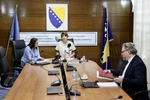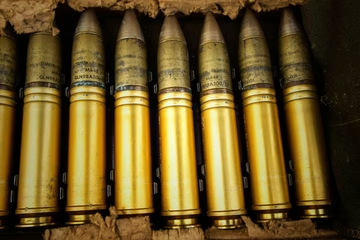
South Korean fighter jets fired more than 300 warning shots at a Russian military aircraft Tuesday after it twice violated the country's airspace, defence officials said.
In a statement, South Korea's Joint Chiefs of Staff said that a Russian A-50 command and control military aircraft twice violated South Korean airspace off the country's eastern coast on Tuesday morning.
The South Korean military said they flew above islands claimed by both South Korea and Japan, first at 9.09 a.m. local time and then again at 9.33 a.m., each time for just a matter of minutes.
The two, small disputed islands are known to the Koreans as Dokdo and to the Japanese as Takeshima. They're situated about halfway between both countries.
In response, South Korea deployed F-15F and KF-16 fighter jets, the statement said and fired 360 warning shots ahead of the Russian aircraft, 80 during the first violation and 280 during the second. The shots were fired using a 20mm weapon, according to the Ministry of Defence.
The South Korean military said they also sent out 30 warnings to the Russian plane but received no response.
It is the first time a foreign country has violated South Korean airspace, according to the ministry. Chung Eui-Yong, director of South Korea's National Security Office, said that he had sent a "strong" message of complaint to the Russian authorities over the incident.
"We are taking this situation very seriously, and if this kind of action is repeated, we will take even stronger measures," Chung said, without detailing what those measures could be.
Carl Schuster, a former director of operations at the United States' Pacific Command's Joint Intelligence Center, said that shooting a warning shot in the air was "very very serious" and "very, very rare."
Schuster said that the fact shots were fired meant Seoul had viewed the violation as a serious and deliberate act, adding he couldn't explain why the Russian plane would come back again after the first warning.
"Penetrating to a point of requiring warning shots to turn away is normally the result of a deliberate decision to penetrate that airspace," he said.
It was one of two incidents involving South Korea, Tuesday. According to the country's Joint Chiefs of Staff, two Chinese H-6 bombers entered South Korea's Air Defense Identification Zone (KADIZ) earlier on Tuesday.
Airspace is defined as the area 12 nautical miles from a country's borders, which falls entirely under its control. An ADIZ is an area in which the controlling country demands identification, location and control of aircraft's direction, but doesn't necessarily have any rights of engagement under international law.
South Korea's KADIZ was first established in 1950 and most recently adjusted by Seoul in 2013.
The two Chinese bombers entered the KADIZ at 6.44 a.m. local time and then 7.49 a.m., after which they met up with the two Russian TU-95 bombers.
The four planes then entered the KADIZ together at about 8.40 a.m. and remained there for 24 minutes, according to the Joint Chiefs of Staff.
It isn't immediately clear whether the Russian A-50 Awacs intentionally violated South Korean airspace. The incident is unusual. Though East Asia is riven by numerous, long-standing territorial disputes, Russia and South Korea rarely come into conflict.
Top Russian and South Korean leaders at the G20 in Osaka, Japan, in June, where they praised their warming bilateral relations.
Russian President Vladimir Putin said South Korea was "one of our key partners" in Asia. It is the second tense incident involving the Russian military in East Asia in less than two months.
On June 8 two vessels from the US and Russia almost collided in the Pacific, coming within 50 feet of each other. The exact location of the standoff wasn't clear but it was believed to take place in the waters off the coast of China.
Relations between Beijing and Moscow have reached an "unprecedented" peak in the past year, according to Russia's Putin, including growing cooperation between their two militaries.
Kakvo je tvoje mišljenje o ovome?
Učestvuj u diskusiji ili pročitaj komentare





 Srbija
Srbija
 Hrvatska
Hrvatska
 Slovenija
Slovenija



























































